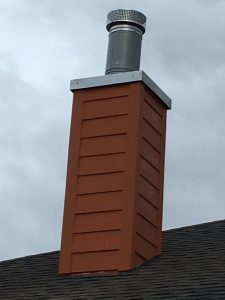A chimney is more than just bricks and a fireplace. As a homeowner with a fireplace, it is important that you are knowledgeable about the different parts of a chimney. This comes in handy when you need help to spot any problems.
Exterior Parts of a Chimney
 Bricks
Bricks
Bricks are the foundations of the chimney and has to be in good condition for the efficient performance of the fireplace. Deteriorated or damaged bricks can allow moisture into the chimney.
Chimney Cap
Chimney caps are fitted on top of chimneys, thus offering protection from animals, birds, snow, rain, and even debris.
Chimney Crown
Often easily confused with chimney caps; they are also fitted on top of chimneys but are found on masonry chimneys and not factory-built ones or prefabricated. A crown is the slab of concrete that vastly covers the opening of your chimney. The cap covers opening is left where the smoke comes out of.
Chimney Chase Top / Covers
A chase top or cover is what covers the opening of a prefabricated or factory-built chimney; It serves the same purpose as a chimney crown on a masonry chimney. It can be made of galvanized steel, stainless steel, aluminium or copper.
Chimney Flashing
This part is found where the chimney meets the roof and guards against moisture penetration. Chimney flashing protects not only your chimney but also your rooms and attic underneath the area.
Interior Parts of a Chimney
Smoke Chamber
The smoke chamber is where smoke first enters on its path to the out of the room. It is engulfed by sloped walls that help ease the smoke’s passage through to the flue. Inside the chamber is the smoke shelf. This is a flat area whose function is to grab any moisture or debris entering through the top of your chimney. It is important that you have it cleaned yearly as it often gets clogged with soot and creosote.
Fireplace Damper
The fireplace damper is the piece that opens and closes your fireplace to the chimney, and as a homeowner, you are advised to keep it closed when the fireplace is not in use to keep drafts out of your house. When using the fireplace, open up the damper to allow the smoke to come out of the room. A well-functioning damper is one of the most important parts of a chimney.
Chimney Liner
Chimney liners envelop the walls of your chimney thus leading smoke up and out of it. For homeowners with a masonry chimney, go for stainless steel.
Chimney Flue
The chimney flue is the passage through which smoke from the fire travels up and out of your home. It needs an annual inspection as it is prone to soot and thus susceptible to fire.
How To Clean a Chimney
Stage one
Cover the furniture and put on some clothes you don’t mind getting dirty. Place the fireplace grate and fireplace andirons in a plastic garbage bag; this is aimed at stopping them from dropping ash everywhere. Use coffee grounds to keep the dust down then scoop the ashes using a shovel and into a bucket. The bits of ashes can be cleaned using a brush and a dustpan.
Stage two
Use a newspaper to line the floor of the fireplace to catch the debris that falls off the firebox walls. If you have a fireplace screen, brush it from the top down. Scrap the firebox walls with a wire brush to remove the soot buildup. Make a paste of baking soda and water, apply it to a scrub brush, and scrub the walls. This aids in stain removal. Roll the newspaper gently to ensure no debris escapes. If your fireplace has glass doors, clean them using a glass cleaner.
Stage three
Use a flashlight to carefully inspect the chimney walls for debris and creosote buildup and animal nests. Creosote is black or shiny brown or black deposits or dry, cracking flakes. Remove in case of buildup before lighting another fire. Remove any nests or other debris you find inside the chimney. If you notice animals like the raccoons or bats, be careful not to approach them especially if they are parenting since parenting animals are known to be aggressive and their bites can cause rabies. If you do not have a chimney cap, install one to prevent further animal invasions.
The fireplace grate and fireplace irons that you had put in a garbage bag, take them out for cleaning. Apply a detergent, scrub with a wire brush and hose them down. Afterwards dry with a paper towel and replace them at the fireplace.
Cleaning your chimney on your own can be quite a daunting and laborious task. We recommend finding a good chimney sweep to help you enjoy your fireplace all year long. Fill out the form below to learn more about how we can help you keep your chimney and your home safe and clean.

 Bricks
Bricks